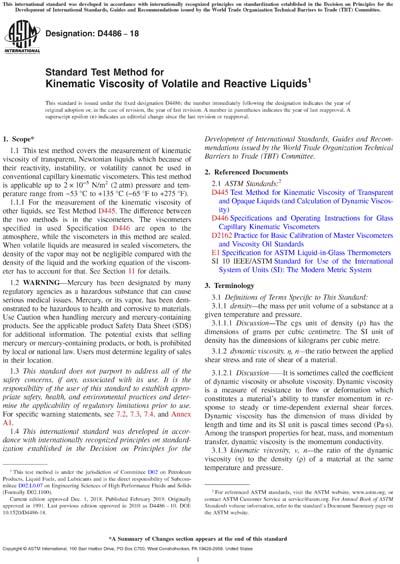Historical
ASTM D4486-18
Standard Test Method for Kinematic Viscosity of Volatile and Reactive Liquids
1.1 This test method covers the measurement of kinematic viscosity of transparent, Newtonian liquids which because of their reactivity, instability, or volatility cannot be used in conventional capillary kinematic viscometers. This test method is applicable up to 2 × 10−5 N/m2 (2 atm) pressure and temperature range from −53 °C to +135 °C (−65 °F to +275 °F).
1.1.1 For the measurement of the kinematic viscosity of other liquids, see Test Method D445. The difference between the two methods is in the viscometers. The viscometers specified in used Specification D446 are open to the atmosphere, while the viscometers in this method are sealed. When volatile liquids are measured in sealed viscometers, the density of the vapor may not be negligible compared with the density of the liquid and the working equation of the viscometer has to account for that. See Section 11 for details.
1.2 WARNING—Mercury has been designated by many regulatory agencies as a hazardous substance that can cause serious medical issues. Mercury, or its vapor, has been demonstrated to be hazardous to health and corrosive to materials. Use Caution when handling mercury and mercury-containing products. See the applicable product Safety Data Sheet (SDS) for additional information. The potential exists that selling mercury or mercury-containing products, or both, is prohibited by local or national law. Users must determine legality of sales in their location.
1.3 This standard does not purport to address all of the safety concerns, if any, associated with its use. It is the responsibility of the user of this standard to establish appropriate safety, health, and environmental practices and determine the applicability of regulatory limitations prior to use. For specific warning statements, see 7.2, 7.3, 7.4, and Annex A1.
1.4 This international standard was developed in accordance with internationally recognized principles on standardization established in the Decision on Principles for the Development of International Standards, Guides and Recommendations issued by the World Trade Organization Technical Barriers to Trade (TBT) Committee.
Content Provider
ASTM International [astm]






